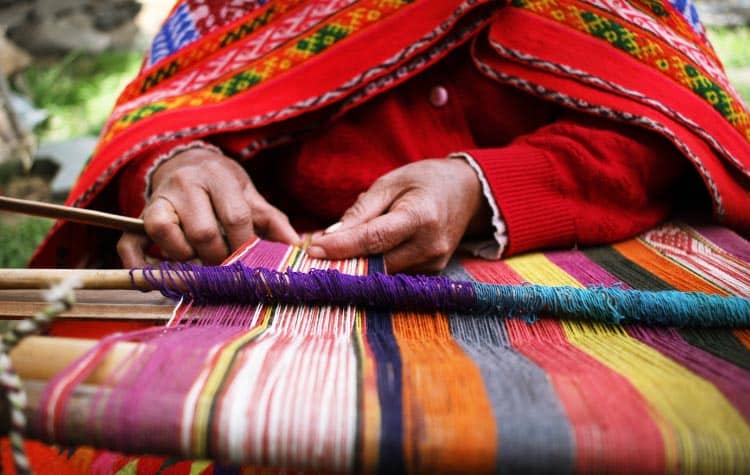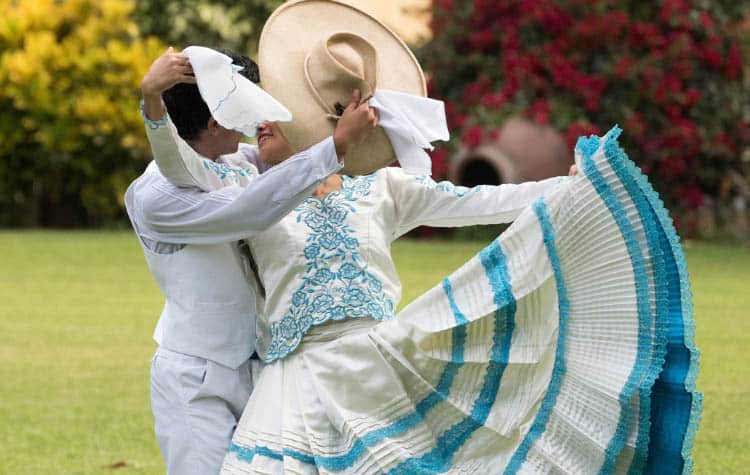
As a melting pot of cultures and a cradle of ancient civilizations, Peru has a diverse and vibrant culture that is constantly evolving through artwork, handicrafts, gastronomy, and more. Arts and culture experiences in Peru are one of the many ways that indigenous peoples preserve their heritage and language. Visitors have the unique opportunity to experience the many cultures of Peru while supporting local communities in preserving their culture. Kuoda can plan your cultural excursion through Peru with a variety of tours and experiences around the country.
1. Traditional Textile Class in the Sacred Valley

Textile weaving is an ancient Incan tradition that spans centuries in Peru. Now, visitors have the opportunity to learn how it is done from master weavers, awarded by UNESCO for their dedication to protecting this sacred craft.
Upon your arrival at your workshop, you will receive a warm welcome from the artisans, who will provide a tour of the workshop and an expert explanation of the traditions of Incan textile weaving in Peru and how each part craft from dyeing to weaving has evolved over hundreds of years to become a way for the community to preserve their culture. Enjoy a day spent with the indigenous people of the Sacred Valley and explore the intersections of Incan art and culture in this community-led workshop.
2. Experience Peruvian Folklore in Puno

Though most people come to Puno to explore the nearby famous Lake Titicaca, this Andean town has a richness of culture unlike anywhere else in the country. Puno is considered the Folklore Capital of Peru and is renowned for its music and dance, showcased in several major annual festivities. The largest of the lot is the Festival of the Virgin of Candelaria, which is held annually in February and is one of the three largest festivals in all of South America.
Over 300 different local dances originate from Puno, representing centuries-old traditions inherited from the Incas and the Spanish. Folk dances and songs are accompanied by colorful costumes and masks to celebrate Catholic holidays or Inca celebrations related to the agricultural calendar. These celebrations come from a mix of Catholic and Incan influences and often depict the relationship between men and God, to honor Andean Gods, Catholic saints, and the Virgin Mary.
Kuoda is in the know with folklore events and experiences happening in Puno and can ensure a folklore-focused visit to Puno takes place on your luxury tour to Peru.
3. Coffee Tour in Chanchamayo

In the Andean foothills of Central Peru lies a town that produces some of Peru’s most celebrated specialty coffee, Chanchamayo. This area is also known for producing some of the highest quality coffee beans in the entire country, which translates to a great aroma and taste in your cup. Coffee farmers plant the beans at an elevation of about 5,000 feet and then handpick them.
In a region where coffee is one of the main sources of economic prosperity, coffee has become an integral part of the culture of the natives who live and breathe coffee as a means of living and have perfected the craft of artisan coffee making in Peru. In a coffee tour of Chanchamayo, visitors can learn about the process of coffee production in this world-famous coffee region – from the ideal season for planting and harvesting, to how the beans are cleaned, blessed, and packaged before being sold. Meet with local coffee makers, taste some of the delicious coffee from the region and understand how coffee plays a pivotal role in the culture and livelihoods of this region.
4. Marinera Dance Festival in Trujillo

Each January, the colonial city of Trujillo located in Northwestern Peru hosts the Marinera Festival, which brings hundreds of dancers and thousands of spectators from across Peru and internationally. Taking place at the peak of the Peruvian summer, the Marinera Dance Festival is a 10-day festival that features parades, demonstrations, and national competitions for marinera dancers. This is one of Peru’s most lively events that can’t be missed on your luxury tour to Peru!
Trujillo has been recognized by the Peruvian government as the National Capital Marinera. Accordingly, the Trujillo Marinera Festival is one of the most important cultural events in not just the city, but all of Peru. Parades of brass bands, ornately costumed dancers, and festively decorated vehicles wander through the streets, before ending up at the Plaza de Armas, where marinera dancers delight the crowd with their moves. Traditional northern-Peruvian dishes are served during this time, such as frijoles y cabrito, Peruvian beans, and stewed kid goat, and arroz con pato, duck in seasoned rice, all washed down with great quantities of the local beer, Pilsen Trujillo.
5. Inti Raymi in Cusco

Every June 24, the Sun God is the protagonist of one of the most important and traditional festivities celebrated in Peru: The Inti Raymi or “Sun Festival”. During this date, thousands of national and foreign tourists walk the streets of the historic center of Cusco and congregate on the esplanades of its main sites to experience a special day of cultural activities whose purpose is to revalue the Inca legacy and celebrate the Incan New Year.
There are more than 800 people, including actors, dancers, and musicians who – dressed in typical clothing – star in a series of scenes that include dances, performances, and praises performed outside the Main Square of the city. On March 3, 2001, the Inti Raymi was declared Cultural Patrimony of the Nation. Its organization and production is now in charge of the Municipal Company of Celebrations of Cusco (EMUFEC).
6. Pre-Hispanic Pottery Making Classes Near Pisac

Peru has a rich and extensive history when it comes to pottery. Pottery from the Sacred Valley, in particular, has garnered a reputation as a bastion of traditional ceramics. Peru, in ancient times, was a hotbed of prominent Andean civilizations. The Incas were the most renowned of the bunch. They, along with their hordes of pottery-based treasures, were captured by the Spanish conquistadors in 1533.
Throughout the Inca’s civilizations, pottery production was an art form that was highly developed. There were two main purposes of pottery during the Inca reign: utilitarian and ceremonial. Ceremonial pottery was used for ceremonies and they are known as huaco.
The traditional town of Pisac is the perfect backdrop to learn more about Andean pottery. Known for its bustling handicraft market which serves as a center of commerce in the town, craftspeople from all over the country gather in Pisac to exchange pottery, textiles, and more. In a pottery-making class, visitors can learn from innovative craftsmen who are familiar with and employ different techniques and technologies associated with pottery production and understand how the Incas produced their pottery hundreds of years ago. In his workshop, you will have the opportunity to learn how this process was conducted, and to make with your own hands a piece of Inca pottery.
7. Street Art Tour Through Barranco

Like a real-world canvas, Barranco’s colorful street art has become a dominant scene here in the city. Melodically mixed with the district’s timeless colonial architecture, Barranco’s thriving and ever-growing street art scene has transformed the district into something altogether unique. While the street art scene is highly visible on its surface, it takes an insider to know the history of the scene, its artists, and their stories.
Great for all ages and interest levels, the tour offers the perfect opportunity to walk Barranco’s most historic and charming streets filled with inspiring street art. We recommend that you wear comfortable clothes and shoes, and bring your cellphone/camera fully charged with space for photos.
8. Learn About the Indigenous Inhabitants of the Uros Islands

The floating Uros islands feel like something out of a fairytale, with all structures on the islands made entirely from totora reeds. The lives of the inhabitants of these artificial islands are entirely dependent upon the reed beds they live among.
From boats for fishing to houses to handicrafts – all on the island is made from totora reeds as they have been for hundreds of years, by the Uro-Aymara families who made their home on the lake. People of this community offer their work to visitors as a souvenir of their visit to this magical place.
Visiting the indigenous culture and gorgeous scenery of Uros Islands is a one-of-a-kind experience in which visitors will have the opportunity to explore the sublime scenery, unique wildlife, and fascinating culture of these man-made islands. Visitors can enjoy true local hospitality as you spend the day learning to fish, trap birds, and cut reeds with the islands’ residents, all set amidst the lake’s gorgeous natural environment. Spend the day on a cultural immersion amidst the Uros Floating Islands of Lake Titicaca and get a sense of the unique culture of this beautiful Andean region. Visiting the Uros islands as you learn to fish, trap birds, and cut reeds with the locals in a cultural immersion like none other in South America.
Arts and Culture Experiences in Peru with Kuoda
Experience Peruvian culture through hands-on experiences with local craftsmen, historians, artists, and community leaders. Let Kuoda plan your luxury tour to Peru to immerse yourself in the many cultures, traditions, and art that the country has to offer and travel sustainably by helping preserve the culture of local communities.
How To Experience Peruvian Artwork and Craftsmanship on Your Next Tour To Peru
Peru’s rich heritage is brought to life through its vibrant handicrafts. From colorful textiles to intricate...
Read PostKuoda’s Guide to the 2024 Inti Raymi Festival
The 2024 Inti Raymi festival will stand as a tribute to the grandeur of the Inca Empire, steeped in centuries ...
Read PostFascinating Facts You Should Know About the Incas
Curious to know some facts about the Incas? Explore Inca Heritage with Kuoda Travel. Well, for starters, depen...
Read Post

 Call
Call 























